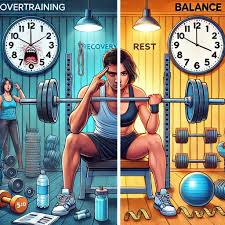Engaging in regular exercise is crucial for a healthy lifestyle. However, when you overdo it, exercise can lead to negative consequences for your body and mind. Finding the right balance is essential to achieving your fitness goals while avoiding the pitfalls of overtraining. This article explores the dangers of over-exercising, its warning signs, and how to maintain a sustainable exercise routine.
What Happens When You Exercise Too Much?
Over-exercising, also known as overtraining, occurs when the volume or intensity of your workouts exceeds your body’s ability to recover. While pushing your limits can be beneficial in moderation, consistently overloading your body can lead to a range of physical and mental health issues.
Physical Risks of Overtraining
- Increased Risk of Injuries
- Overuse injuries, such as stress fractures, tendonitis, and muscle strains, are common among individuals who exercise excessively. These injuries occur when muscles and joints do not get adequate time to recover.
- Weakened Immune System
- Prolonged overtraining can suppress immune function, making you more susceptible to illnesses like colds and infections.
- Hormonal Imbalances
- Excessive exercise can disrupt hormonal regulation, leading to issues such as reduced testosterone levels in men or menstrual irregularities in women (amenorrhea).
- Cardiovascular Stress
- Intense exercise without rest may cause heart complications, such as arrhythmias or an increased risk of cardiovascular events.
Mental and Emotional Risks
- Chronic Fatigue
- Overtraining often leads to extreme tiredness that doesn’t improve with rest.
- Mood Swings and Irritability
- Physical exhaustion from overtraining can contribute to feelings of frustration, irritability, and even depression.
- Burnout
- Overdoing exercise can lead to mental exhaustion and a loss of motivation, reducing overall enjoyment and adherence to physical activity.
Warning Signs of Overtraining
Recognizing the signs of over-exercising is key to preventing serious health consequences. Here are common indicators:
Physical Symptoms
- Persistent muscle soreness and stiffness.
- Frequent injuries or nagging pain.
- Decreased performance or plateau in fitness progress.
Emotional and Mental Symptoms
- Lack of motivation to exercise.
- Difficulty sleeping or insomnia.
- Increased feelings of stress or anxiety.
Behavioral Changes
- Skipping rest days despite fatigue.
- Obsessive focus on workout routines or calorie tracking.
How to Strike the Right Balance in Your Exercise Routine
Achieving your fitness goals without compromising your health requires a well-rounded approach. Here’s how to find the right balance:
1. Listen to Your Body
- Pay attention to physical and mental cues. If you’re feeling overly fatigued or unmotivated, it’s time to scale back your workouts.
2. Incorporate Rest Days
- Rest days are crucial for muscle recovery and overall health. Plan at least 1-2 days of rest each week to allow your body to repair and rebuild.
3. Mix Up Your Workouts
- Varying your workout routine with different activities (e.g., strength training, cardio, yoga) can prevent overuse injuries and keep you engaged.
4. Set Realistic Goals
- Establish achievable fitness objectives that prioritize consistency over intensity. Focus on long-term health rather than short-term gains.
5. Prioritize Nutrition and Hydration
- Proper nutrition supports recovery and energy levels. Ensure your diet includes adequate protein, healthy fats, and carbohydrates, along with sufficient hydration.
6. Consult with Experts
- Work with a certified trainer or physical therapist to create a personalized workout plan tailored to your needs and fitness level.
7. Track Your Progress
- Monitoring your workouts and recovery can help you identify patterns and make necessary adjustments to prevent overtraining.
The Role of Recovery in Fitness Success
Recovery is not a sign of weakness; it is an integral part of any effective fitness plan. Rest allows your muscles to repair, adapt, and grow stronger. Incorporating active recovery activities such as stretching, light yoga, or leisurely walking can also help enhance circulation and reduce stiffness.
Benefits of Prioritizing Recovery:
- Enhanced muscle growth and strength.
- Improved athletic performance.
- Reduced risk of injuries and burnout.
- Better mental focus and emotional well-being.
While exercise is essential for a healthy lifestyle, overdoing it can have serious consequences. By recognizing the signs of overtraining and incorporating adequate rest and recovery, you can enjoy sustainable progress and optimal results. Striking the right balance ensures you stay healthy, motivated, and on track to achieve your fitness goals.
Remember, fitness is a marathon, not a sprint. Embrace a balanced approach, and your body will thank you for it.
Frequently Asked Questions (FAQ)
1. What is overtraining syndrome?
Overtraining syndrome is a condition that occurs when excessive exercise without adequate recovery leads to persistent fatigue, performance decline, and other physical and mental health issues.
2. How many rest days should I take per week?
It depends on your fitness level and workout intensity, but most people benefit from 1-2 rest days per week. Listen to your body to determine what works best for you.
3. Can overtraining affect my sleep?
Yes, overtraining can disrupt your sleep patterns, causing insomnia or restless nights due to elevated stress hormones like cortisol.
4. Is it okay to exercise every day?
Exercising daily can be safe if you alternate workout intensities and prioritize recovery. For instance, balance intense sessions with light activities like stretching or walking.
5. What should I eat to support recovery?
A balanced diet rich in protein, healthy fats, and complex carbohydrates, along with sufficient hydration, is essential for recovery. Include nutrient-dense foods like lean meats, nuts, fruits, and vegetables.
By understanding the dangers of overtraining and adopting a balanced approach, you can enjoy the full benefits of exercise while maintaining your overall health and well-being.